September 27, 2007
Brad Eberhard
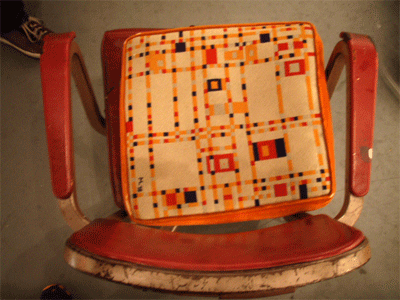
And then Bart said: "That's a blogpost in itself right there.", and snap went my Olympus. I always knew Bart was a blogger at heart.
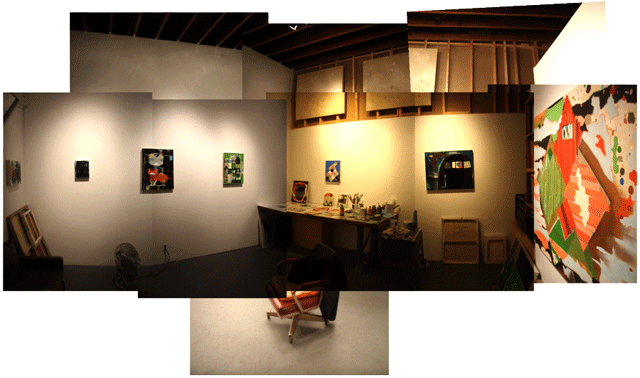
We were in Brad Eberhard's studio on York Boulevard in Highland Park. Here are a few shots of the paintings he had on hand and a few notes of things we talked about that evening:
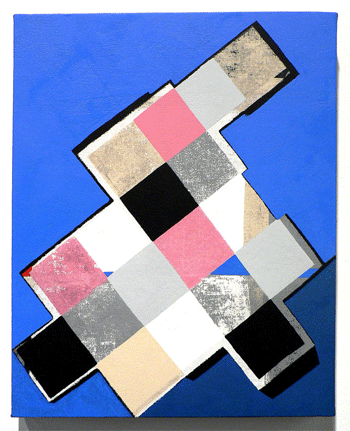
La Estrella
I first became aware of Brad's work last spring, my friends were talking about a painter who was coming out of Claremont (my school by the way) who was a good, intellligent and he led a band to boot. Before I departed for Spain at the beginning of this summer, I happened to see Brad's Wounded Lion at the Mountain Bar one night -a great band composed of artists, painters by the way- (My YouTube video links of that evening are here 1, 2, 3, 4, & 5; the quality of the videos are not that great but there they are.) Shortly after that, I bumped into Brad at a show that he curated at High Energy Constructs (Time Machine)and I was impressed with both the show and the curator too.
With all this, I was keen on seeing his work in the flesh, a studio visit was inevitable. Driving up there with Bart Esposito, that part of Los Angeles seemed the same as it ever was: a stucco scruffy melange of garages, thrift stores, bars and taco joints (more than that of course, but this short list has a flavor that represents well enough the character of the place). Located behind a gallery by the name of Sea and Space Exploration, Brad's studio was one of several in an artist's warren of pocket studios tucked behind the peeled paint and acid tagged glass commercial frontage of York Boulevard in the middle of Highland Park/Eagle Rock. The place felt great, a nice community where artists bumped in and out with groceries and dogs through alleys stacked with studio debris and artwork wrapped in plastic.
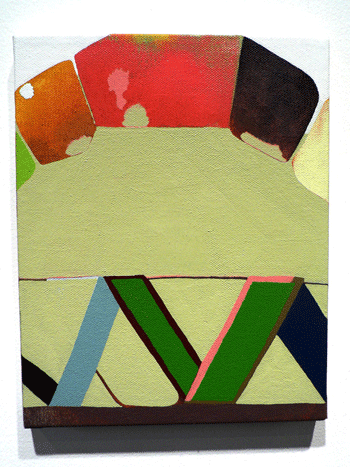
Ripchord
Since he was fresh out of grad school, it was of no surprise to feel reverb of the academic environment in the layout of his studio (severe cubicle space economy in the disposition of his paintings, equipment and supplies) and in his conversation. He was sweating off the analytic 'tude in the way he talked about his work, the after effects of the necessary immersion into the critical attitude in grad school studio discourse. I could tell that he was a kindred spirit, aware as he is that while it is important to absorb the idea and spirit of criticality in his relation to art, there was also a problem in manifesting an unselfconscious criticality. It was important to be critical of criticality, a governor that can keep us from flying off the handle.
I heard recently that there was a group of artists locally that would meet in each other's studios and manifest a crit session that would acid wash their colleague's artwork. I imagine it was the typical take down, tear down challenge test-to-failure that we were introduced to in school. That was fine enough in school, it is proper to introduce a level of self consciousness that might induce an awareness of the dialogue of art as it exists and in its' history... but I think that it is misguided to elevate it into a standard practice after school. The purpose of the take down crit is to impart a critical mentality (remember going to museums and art exhibitions with haughty dismissive attitudes when you were a kid?) but more importantly to construct a jury in our own heads, within us... voices minted from our own heros so that when we are alone in the wee hours in our own studios, we might be able to critique our own work before we show it to the world. An Occam's Razor to inflict yourself with. Criticality is an instrument, a means to an end, and an unselfconscious absolutist application of it leads to Taliban dead ends of literalism and illustration.
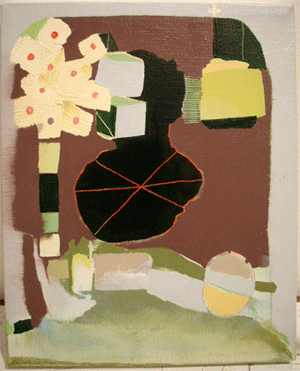
I won't say here that Brad shares this particular idea of mine on a one to one basis, but I believe he shares the spirit of it in that he is careful to distance himself from the typical slavishly deterministic arrangements of meaning that are usually compelled by standard critical theory. To this he turns oblique and focuses instead on his curiosity and enthusiasms. Paul Klee and Jean Arp, for example. Here's a blurb via the LAWeekly's Tom Christie and Holly Meyers:
Brad Eberhard comes to his bright, dense, irresistibly jaunty paintings by way of instinct and free association. Using Dada as a model, he approaches each composition as a collage, assembling impressions from an idiosyncratic array of archaeological, art-historical and popular sources, and formulating elaborate, if not always obvious, schemes of interrelation. Paul Klee leads to Machu Picchu, he suggests, Hans Arp to the covers of Blue Note jazz records to Raymond Pettibon?s Black Flag logo. ?Concocting based-on-a-true-story lineages like this keeps me off the overtrod streets of literary theory,? he says, ?lets visual content beget content, posits ?meaning? as local, subjective and weird, and places my work in the tradition of trying to iconically depict freedom and vitality without clich?s such as eagles or drips.?
And true to this snip, Brad shared his treasured copy of Paul Klee's Pedagogical Sketchbook where he talked about curiosity as metaphoric arrows of intention fletching into flight with the the barbs of the arrow point interpreted as the resultant forces of physics and invested with existential significance of the escape velocity of fascinated inquiry. And in all this I see a kindred spirit looking at the Bauhaus, its phoenix-like mandate to recreate art amidst destruction (critical reverb here), at the ability to get high from diagrammatic conceptualization, and in his appreciation for the ability to form a constraining analysis that tightens up such that a force is compelled to burst out into freedom.
Hell yea.
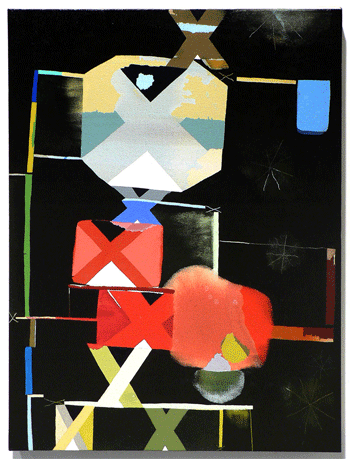
Nightfall
This theme echoed in a couple of diagrams Brad pulled out for reference, one of which was Ben Franklin's Join or Die. Brad spoke of this in his own way, and surely I am warping his interpretation of it with my bias, but suffice it to say that the snake represents the world and the cut through the snake represents painting, containing in such a way all of the responsibilities of representing the world via that section. Pressurized constraint and resultant expansiveness indeed. Holographic in that a small part can reflect the whole. Post-post modern painting? Is this a picture of modesty and ambition in a renewed -abstract- painting that has reclaimed its legitimacy after the mulit-modal genre expanded field of the past 50 years?
Well, maybe I should dial down the flight of fancy a bit.
In the studio I could see his Blue Note records next to books selected and stacked carefully in the shelf next to the turntables below pottery arranged on top of it all.
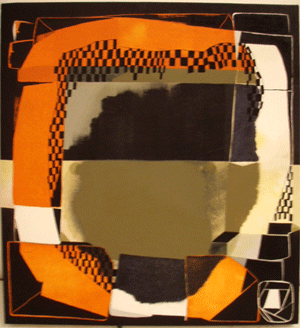
Precision, imprecision. A line that draws distinction, a pool that oozes across boundaries. Imprecision made precise. Precision that makes a pratfall.
Bart was grooving on all of this stuff with the design world oozing from Brad's seams. I think Bart is especially design oriented with his concern for line and preparatory drawing where the arrangement and position of color-line-plane compose his horizon. But here I must place a caveat: Bart is not all that comfortable with my association of his practice to design. It is possible that he is concerned that there are aspects of design's influence in the art world that have been adopted in a superficial manner or that the identity mapped from the world of design might rob painting of its' depth. Perhaps. Think of how in earlier times Cubism devolved into Purism into Art Deco (a shakey formulation I admit but I hope you get the point), or how many contemporary artists recontextualize Pop language into lazy critical theory references of the evacuated sign. As a dormant architect, I regard design as the intersection of context/function/materiality, where intentionality is stressed to the breaking point. I don't automatically see lazy associations between design and painting. Design for me is difficult to employ because I was educated to Fine Art via the Design Arts, I'm too close to it... and I imagine that it is easier for artists to pick and choose from the design world when they approach it from the outside. It is easy for me to think that contemporary painters might employ the design world as a lens to approach abstract painting where every mark and daub is made as far away as possible from the mindless Pollock drip.
I could see design precision in Brad's chisel tipped brushes and in the careful arrangement of his worked surfaces; in Bart's sharp edges and carefully considered colors. It was as if this was all a sailboat, ship shape with the gear proven past the breaking point through stormy sea trials, all reverentially maintained and put away properly. And like a ship, the sailor's life is in no way trivial: design in this context is a matter of life and death.
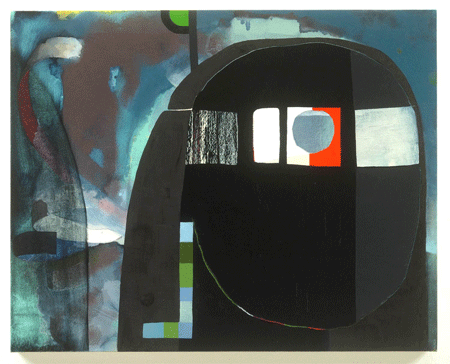
Drifter
Later, after the sun set with the hot topics of painting's practice, Brad suggested a bar that we might have a few beers at nearby. I imagined a dive bar with a goofed up pool table in the back and flamed out neon Budweiser signs behind a delaminating countertop. We walked up a couple of blocks to get cigarettes, Brad told us of all the galleries opening nearby. Man, is this place changing. As we cruised past York, Marty's restaurant and dropped into Johnnie's Bar where the interior is leathered, the space ample and a looped Logan's Run was projected on the wall... I had this overwhelming thought that all of LA was turning into Williamsburg.

Exxrayspex
Leave a comment